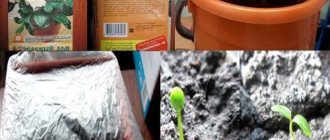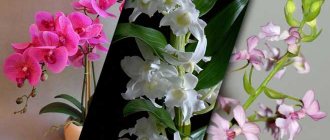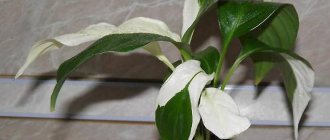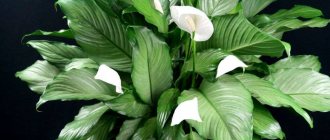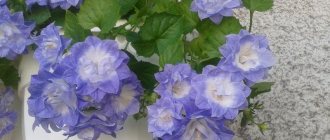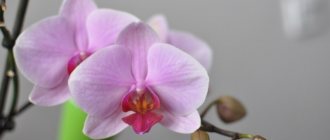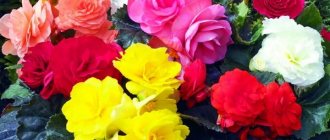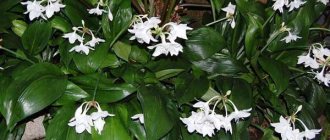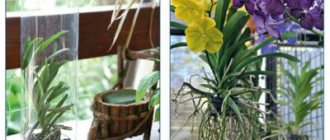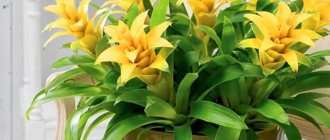Gardenia, as noted earlier, belongs to the madder family. It includes about 250 species (read more about the types of gardenias and popular plant varieties in our material). The flower grows in the subtropical forests of China and Japan. These are small trees and evergreen shrubs. The strong shoots are pubescent, the leaves are opposite and glossy.
The flowers are collected in corymbs, sometimes growing one at a time. At home, the most commonly found plant is gardenia jasmine. This plant tolerates pruning well. But despite the fact that you can easily form a crown, the flower is very demanding to care for.
How does a plant reproduce?
Gardenias are propagated in three ways:
- cuttings;
- dividing the bush;
- seeds.
Only the first method is suitable for home growing. Cuttings should be pruned in autumn or spring. Choose only semi-lignified specimens. Gardenias have an extremely low rooting percentage, so for one-time propagation you will need at least 3-5 cuttings.
Favorable environment
Reproduction of gardenia and further cultivation of young seedlings should take place in a room where there are no sudden changes in temperature. The soil for growing must be sufficiently acidic. Place containers from the plant in a well-lit place, but not in direct sun.
During the formation of buds, you cannot move a pot of gardenia from place to place.
Timing
Since the plant is most often propagated using cuttings, the best time to carry out the cutting procedure is considered to be the beginning of spring or, in extreme cases, the period after the plant has completely flowered.
Description of the flower
Gardenia Jasminoides (Gardenia Jasminoides) has synonyms - Gardenia Augusta, Cape jasmine. This is an evergreen plant from the Mirenaceae family. It is native to the tropical forests of India, China and southern Africa. There it grows, most often in the form of shrubs, but there are trees up to two meters in height.
- Indoor specimens usually grow to sizes of 60–80 cm.
- The shoots are smooth, bare, highly branched, woody.
- Dark green leathery leaves, up to 8 cm long, grow in pairs on short petioles. In shape they are broadly lanceolate or reverse ovoid, glossy, narrowed towards the base.
- Gardenia jasmine blooms in nature twice a year.
- It has oval, pointed at the tip, leathery, dense leaves.
- It blooms with large double or simple fragrant white flowers up to 8 cm in diameter.
- When optimal growing conditions are created indoors, it can grow well for up to 7-8 years.
The beautiful shape of the Gardenia flower with originally arranged glossy petals is reflected in needlework. Craftswomen create with their own hands unique kanzashi in the form of Jasmine Gardenia flowers to decorate brooches, hairpins, hairbands, as well as gifts from polymer clay.
The scent of Gardenia Jasmine is used by famous perfume brands, such as: Nina Ricci Premier jour, Dior Addict Shine, Chanel Gardenia, Dior Miss Dior, Estee Lauder Intuition, Agent Provocateur, Guerlain Cruel Gardenia.
In addition to its spectacular appearance and unique aroma, Gardenia is valued for its healing properties. For example, the roots and fruits of this plant are used to prepare medicinal decoctions for the treatment of tonsillitis, stomatitis, and jaundice. They are used to make antipyretic, anti-inflammatory and hemostatic agents.
Reproduction
Gardenia jasmine can be propagated at home in several ways. Breeders and professional flower growers will choose planting seeds - a reliable way to grow a plant without losing its species and with minimal risk of changing its decorative properties. But this path is more difficult and beginners are recommended to choose vegetative planting of seedlings.
Gardenia jasminoides propagating by cuttings involves their rooting. Semi-lignified cuttings are selected after the flowering period, as well as at the time of pruning or replanting the plant. It is optimal to select cuttings about 9-10 centimeters long.
For the steam to sprout, you need to:
- soak the cuttings in a weak solution of potassium permanganate for a couple of hours before rooting;
- root in a sand-peat substrate, proportion one to one;
- create a greenhouse with a temperature regime of +25 °C - place a cutting rooted in the soil under a glass cap or plastic film;
- expect roots to appear;
- When leaves and roots appear, they make it possible to evaluate when it is possible to transplant the “new resident” of the house into a separate pot;
- after a short period of adaptation in the pot, the cuttings are lightly pinched at the top for lush growth and better development.
The greenhouse must be ventilated and create an optimally soft air flow, avoiding drafts, and the substrate must be kept moist.
Gardenia jasminoides are not often grown from seeds, but if you wish, you should adhere to strict rules for caring for the capricious plant. To do this you need to do:
- seedlings are planted in a substrate in the spring, covered with a 3-5 mm layer of earth;
- lightly press for better grip and moisten the soil;
- the soil with seedlings is covered with a glass cap or film to create greenhouse conditions;
- It is better to place the seedlings on a southern windowsill;
- It is expected that within 30 calendar days the seedlings will slowly begin to sprout.
Propagating gardenia vegetatively is faster and more profitable.
Propagation by cuttings
This plant is considered difficult to root. It is more correct to take cuttings during the winter pruning period (late winter - early spring until April). Repeated cuttings are allowed in the summer - before flowering, but no later than in June-July. For cuttings, apical half-lignified cuttings from last year's shoots 8-12 cm long with leaves are suitable.
A suitable substrate for rooting is the same as for rose cuttings. It should be loose, light, airy, permeable to moisture and air. A mixture of sand, turf, and vermiculite is suitable. Coconut fiber and perlite should be used due to the presence of calcium in them. There is an option for rooting cuttings in peat tablets. There are also cases of rooting in water.
Process of planting cuttings:
- The bottom cut should be even and smooth.
- The cutting must be inserted 1-1.5 centimeters into the soil, but the lower leaves should not touch its surface.
- Overly large leaves on cuttings are shortened by a third in order to prevent them from evaporating a lot of moisture. The leaves are not cut off near the uppermost axil; the growth point arises there.
- You need to leave at least a couple of leaves on the cutting so that they nourish the plant until roots appear.
Pests and diseases
As mentioned earlier, gardenia is quite demanding of conditions. If you do not take care of creating the necessary microclimate, the plant may get sick. The most common problems are related to overwatering. As a result of rotting of the root system, the flower begins to wither, turn black, and possible massive loss of leaves and buds. In this case, it is necessary to remove the plant from the pot, separate the damaged part of the root, add drainage and replace the soil. After transplanting, it is necessary to carefully monitor watering.
Culture quite often becomes a favorite delicacy of various pests. The greatest harm comes from thrips, aphids, scale insects, and spider mites. Their appearance can be determined by various signs, for example, the presence of scale insects is characterized by the appearance of brown spots, thrips leave grayish dots on the leaves, aphids leave sticky secretions, and the appearance of cobwebs indicates that the plant is being attacked by a mite. Insecticidal preparations such as “Decis”, “Intavir”, etc. are used to control pests. In mild cases, even a single spraying can help; in difficult cases, three treatments may be necessary every 10 days.
Further care
In order to see the first flowers a year after rooting, you need to follow the basic rules of care:
- strict temperature regime;
- feeding;
- correct watering.
So, let's look at the main points of caring for gardenia.
Lighting
The flower prefers a lot of light, however, direct exposure to sunlight is contraindicated for it, since it has a bad effect on the foliage, which will begin to turn yellow and become covered with brown spots. In summer, it is best to place a gardenia pot in a shaded place.
Gardenia flowers reach up to 8 centimeters in diameter.
In winter, sunlight will no longer be so destructive, and the plant can be moved.
Temperature
In summer, the optimal temperature is 22 °C, in winter from +16 to 22 °C. The temperature regime of the soil and air should not have strong differences so that the roots do not become overcooled. A pot placed on a windowsill should not be moved or rotated in cold weather; this is dangerous for the life of the flower. In the warm season, the bushes can be taken outside, but protected from the burning sun. Important! A tropical plant reacts very sharply to sudden changes in temperature and drafts; it is also undesirable to place pots near air conditioners.
Humidity
The tropics are characterized not only by high air temperatures, but also by high humidity, which must be taken into account when caring for gardenia at home.
You can create additional humidity around the gardenia in different ways:
- place a jar of water near the pot for evaporation;
- grow gardenia near an aquarium with fish;
- purchase a special humidifier;
- spray the plant with a fine spray bottle (this can only be done before buds and flowers have formed on the plant; after that the procedure must be suspended);
- wipe the leaves with a damp cloth or rag (by removing dust, you help the plant breathe)
Watering
In winter, Augusta does not need to be particularly flooded. 2-3 waterings per month will be enough. Starting in mid-March, when buds are actively developing, change your approach to soil moisture. As soon as the top layer begins to dry out, immediately add life-giving moisture.
Pre-settle the water and warm it up a little. You can add a little citric acid or peat to a container of water. If you delay watering, you will notice that the leaves will begin to turn yellow.
Feeding and fertilizers
The need for feeding is determined by the stage of the plant's life cycle, as well as the time of year.
During active growth, gardenia should be fed at least twice a month. Liquid fertilizers designed for indoor flowers, which are sold at any flower shop, are perfect for this. It is important that the dose required for gardenia is half that indicated in the instructions.
In summer, you can fertilize gardenia by alternating mineral and organic fertilizers.
In the autumn and winter seasons, when gardenia is dormant, the plant should not be disturbed - no feeding is required.
Trimming
To ensure that hydrangea produces as many side shoots and flower buds as possible, you need to pinch off the young tops. This must be done all the time while the ward is developing, that is, in spring and summer. At the same time, get rid of diseased and weak leaves and dried flowers. If you leave the seeds to ripen, it will take a lot of energy from the flower.
After flowering, do a “general” cleaning, getting rid of excess shoots and forming a beautiful crown. But even shorten all remaining stems by a third of their height. This procedure will allow Cape jasmine to bloom magnificently next year. You don’t have to throw away healthy cuttings, but use them to produce new flowers.
Growing gardenia from seeds
Gardenia seeds photo
Large gardenia seeds can be easily planted one at a time in separate cups, so as not to have to pick them later. But many gardeners prefer to sow in a common container in order to take up less space in the first month of growing. Everyone chooses what is more convenient for them.
- Planting depth is 1 cm, the distance between seedlings is 2-3 cm.
- The sown seeds are sprayed with a spray bottle and covered with film.
- In such a mini greenhouse, the plants will sprout within three weeks.
- Maintenance consists of maintaining constant soil moisture (there must be drainage to prevent stagnation of water) and regular ventilation of the greenhouse.
Gardenia from seeds photo seedlings
- If sowing was carried out in a common container, at the stage of 3-4 true leaves, the plants are planted in separate containers, pinching off the central root, and still covered with bags or transparent jars.
- 7-10 days after transplantation, fertilizing is carried out with a complex preparation for azaleas.
When the seedlings grow up, they are gradually accustomed to open space by removing the cover.
Basic methods
Material for propagation by cuttings can be collected not only from an actively developing plant, but also from a dead one, if it still has at least small areas of healthy lignified shoots. You can collect cuttings after formative pruning.
You can obtain seed material in two ways:
- buy in a specialized store;
- assemble it yourself.
The second method is preferable, since in this case you can vouch for the quality of the seeds. Collecting the seeds is not difficult; you just need to leave a few buds after flowering for them to ripen.
Specimens obtained from cuttings will bloom in a year, those grown from seeds - no earlier than two years.
Where is the best place to put it?
The best place to place gardenia is the bedroom. In the bedroom, a flower will be able to fully demonstrate its magical properties of the element of Wood; it will protect night's sleep and spread an atmosphere of love, trust and mutual understanding. To get rid of financial problems and manifest the power of the Metal element, it is recommended to place a blooming gardenia on a western window. You can put a flower in the nursery, then it will protect you from the whims of the child and maintain a positive aura in the space.
The capricious tropical beauty gardenia is not often found at home. But those who can create favorable conditions for the plant will be rewarded. After all, this plant is capable of creating an atmosphere of love, warmth and kindness in every family.
Transplanting into a new pot
Replanting gardenias, like other flowers, is stressful, so you need to take this issue as seriously as possible and carefully study the features of replanting so as not to ruin your plant.
Replanting after purchase
Any replanting of gardenia during the growing season can lead to bud drop. Therefore, even a purchased flower should be replanted only when the buds and flowers have not yet appeared. However, you shouldn’t delay replanting either - the soil in which the gardenia grows in the store is completely unsuitable for it, and the pot is too small.
Before transplanting, you should give the tropical plant a warm shower. After a few days for the gardenia to adapt, you can begin replanting it.
Soil for gardenia
The main requirement for soil is acidity. Alkaline soil will quickly cause the gardenia to wilt.
You can use ready-made soil; commercial soil for azaleas or rhododendrons is perfect.
If you like to do everything yourself, then the ideal soil for gardenia consists of equal proportions of:
- soil from under coniferous trees;
- peat soil;
- turf land;
- sand;
- leaf soil.
What kind of pot do you need?
When choosing a pot, an important factor is its volume so that the roots of the plant do not entangle each other, but have enough space to receive maximum water and nutrients.
The optimal pot size should be slightly larger (1.5–2 cm) than the root system of the gardenia. Of course, as the plant grows, its capacity must be increased.
What to do after?
Rest period
With proper care, geraniums can bloom all summer. Therefore, she needs to be provided with a rest period of 1.5–2 months. During this period, the plant cannot be watered or fed. If geranium is grown in the garden, then it is better to transplant it into the house for the winter.
Trimming
Experienced gardeners recommend pruning geraniums every spring. This must be done so that every year it pleases with abundant flowering. It is advisable to pinch the tops of the shoots. They are ideal for further rooting and obtaining new plants.
Transfer
Geranium is one of the plants that does not tolerate transplantation well. Therefore, it should be replanted only in extreme cases.
- If the pot has become small and the roots are cramped in it. It is better to choose small pots, because abundant flowering can only be achieved in cramped containers.
- The plant began to wither.
- Geranium does not bloom and develops poorly.
- The roots of the flower stick out and are exposed.
Do not replant if the plant is blooming. Instead, you can occasionally renew the topsoil.
Is it possible to keep a flower at home?
Gardenia jasmine is a welcome guest in any home. It is believed that the plant has favorable energy and protects your home from quarrels, scandals and troubles. Gardenia emits very soft energetic vibrations, creating an atmosphere of stability and tranquility.
This flower belongs to the element of Wood, so it increases vitality and harmonizes space. But gardenia is that rare species that combines the enormous power of two elements. The element of Wood and bright green leaves indicate its positive influence on the family atmosphere , and the white flower indicates that it belongs to the element of Metal, thanks to which gardenia will help get rid of financial problems.
It is also recommended to plant the plant in a house where there are seriously ill people. Gardenia helps to gain faith in recovery, gives strength to fight and takes away all illnesses and negativity.
